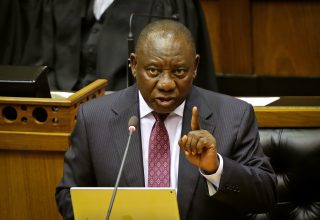Africa’s second largest economy has plunged into another ‘technical recession’ after the country’s GDP shrunk by 0.7 percent in the second quarter of the year. This was officially announced on Tuesday after the release of economic data by Statistics South Africa.
A recession happens after two consecutive quarters of negative economic growth, and that appears to be the case for South Africa. In the first quarter of 2019, South Africa’s economy plummeted by 2.6 percent and another contraction in the second quarter sealed the certainty of another recession for the rainbow nation.
According to the figures released by Stat SA, slow-paced activities in agriculture, forestry, fishing, and the transport industry significantly affected the economy in the last quarter. “The agriculture, forestry and fishing industry decreased by 29.2% and contributed -0.8 of a percentage point to GDP growth. The decrease was mainly because of a drop in the production of field crops and horticultural products,” the statement read.
It is however important to note that there were positives in the figures released by the agency as mining increased by 4.9 percent while finance, real estate, and business services increased by 1.9 percent; all contributing 0.4 of a percentage point to GDP growth. But, sadly, this wasn’t enough to save the economy from dipping, as major contributors remained negative.
Since this development was reported, South Africa’s Rand has also been drawing back in the money market, losing against the Dollar since the beginning of the week. According to a local paper, the plummeting of the rand which ended Tuesday at R15.34/$ might persist amidst a roaring land reform debate in the country.
A major setback
In July, the International Monetary Fund (IMF) predicted that the economic recovery going on will further improve the GDP for the remainder of 2018 and into 2019. Attributing this to a somewhat renewed ‘confidence’ in the new leadership of Ramaphosa who continues to drive policies geared towards improving the economy.
Since his assumption into office, South Africa’s President Cyril Ramaphosa has been seeking support from investors around the world to reverse the fortunes of the country. This birth an investment tour to some countries earlier this year to lure new investors.
However, a recession in the first six months of his administration appears to be more of a stumbling block for the tenacious President who is seeking to raise $100 billion before the end of 2019. In the wake of this incident, reactions trickling in are mainly nailing the Ramaphosa led government and its inability to contain it. Analysts also fear a year-long contraction if viable austerity measures are not put in place.
The Congress of South African Trade Unions (COSATU) has blamed the recent slump on the government’s policies and it’s high dependence on foreign direct investment to revamp the failing economy. “…those interventions have not worked. You will expect an economy to shrink if you increase VAT if you impose sugar tax if you have fuel increases that have led to us having the cost of living that is going to the roof,” said Cosatu spokesperson, Sizwe Pamla.
Consequently, the government has said plans are ongoing to revive the economy before the end of the year as opposition in the country calls for an emergency parliamentary debate. The finance minister who spoke on behalf of the president remains optimistic about a turn around in the coming months.
“The reform package by Cabinet [is] in the pipeline [and] we understand the impatience of South African public because we want things delivered as of yesterday. But some of these things could not be done overnight,” said, South Africa’s Finance Minister Nhlanhla Nene in Beijing, China.
It has been a difficult honeymoon for Ramaphosa who took the reins of power from the vilified Jacob Zuma. This latest development might also be another litmus test for the President after the unemployment rate in the country rose to 27.2 percent in the second quarter compared to 26.7 percent in the first three months of this year.








